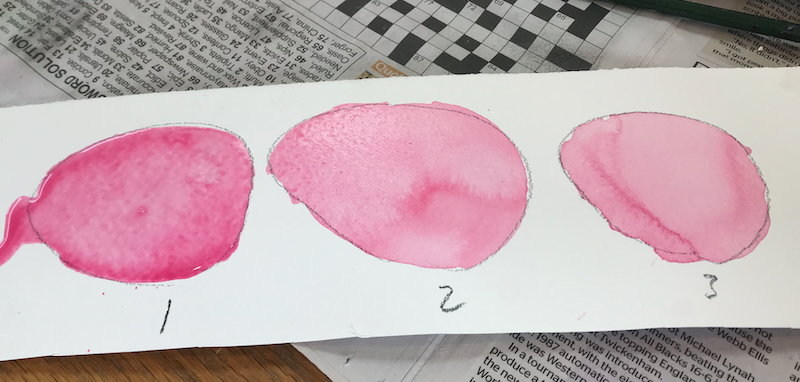
Watching Paint Dry
The other day I decided to move my spinning wheel into the studio as I often find myself waiting for paint to dry and thought that I could usefully fill in the time by spinning some fleece 🙂
This led me to think about watching paint dry !
One of the most important things that you can learn about watercolour is how the paint dries and what you can expect of it at each stage in the process. And watching it dry is the best way to learn.
Here’s a useful exercise to get you started.
Make up a puddle of watery colour and paint it on to a piece of watercolour paper, maybe a patch about the size of an apple To begin with you’ll see that the water has a curved top (the meniscus), sitting above the surface of the paper, and it’s very glossy. (Puddle no.1)
If you sit and watch it for a few minutes you’ll notice that the puddle has settled lower into the paper, as the water is absorbed. There’s still a gloss to it , but not as much. (Puddle no.2)
The paint continues to be absorbed, with the gloss slowly disappearing . At this point the paint is still not quite dry…. The paper will feel cold to the touch if you lay the back of your hand on it (your palm is not as sensitive ). Once the paper no longer feels cold and the gloss is completely gone then you know that the paint is dry.(Puddle no.3)
At different stages during this process you can try different things with your paint.
While it’s still very wet and curved you can drop in other colours (wet in wet painting) or you can tilt your board around and let the water carry the paint around.
Once the gloss starts to disappear things get a bit trickier. You can still add more paint BUT if it has too much water (more than what’s still on the surface of the paper) then the new paint may get sucked into the slightly drier paint, causing cauliflowers.
At this stage you can accidentally smudge the paint too, which can be annoying!
Once the shine has gone completely it’s safe to go over the top with another colour, or to paint up to the first area without fear of fuzzy edges.
A number of things will affect the timing and the way that the paint dries:
The type of paper you work on- some are much more absorbent than others
The size of brush that you use- a bigger brush obviously holds more water, so choose carefully and be aware that if you change brushes during the process then the amount of water which is hitting the paper will differ.
The temperature and humidity of the day
As you become more familiar with the way the water behaves you’ll find it easier to plan your painting process, though the unexpected still happens- watercolour is never boring!
Have fun 🙂
Other news….
Wai Knot watercolour : A couple of local artist friends and I are planning to meet once a month in a nice spot to paint and meet others who enjoy watercolour. It doesn’t matter whether you’re a beginner or more experienced, we’d love you to jon us.
This will be very casual – we plan to send out an email saying where /when we’ll meet , so if you’d like to join in please message me and I’ll add you to the email list .We’ll be meeting together around the Nelson/Tasman district.
If you’re an experienced artist looking to join a gallery in Nelson we are looking for a new member at Wall to Wall Art collective, a busy gallery right in the heart of the Nelson CBD. Please contact Nicolle Russell for details : nicole@nicolerussellart.com
2024 calendars – are still available from my website store , and you can also order native bird gift card packs there !
https://www.janthomsonart.com/shop/calendar.htm
I’m hoping to be around the studio a bit more from now on to catch up on some painting so please call in if you’re passing ,
See you soon , Jan


Comments (0)